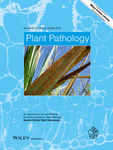Ver ítem
- xmlui.general.dspace_homeCentros e Institutos de InvestigaciónCIAP. Centro de Investigaciones AgropecuariasInstituto de Patología VegetalArtículos científicosxmlui.ArtifactBrowser.ItemViewer.trail
- Inicio
- Centros e Institutos de Investigación
- CIAP. Centro de Investigaciones Agropecuarias
- Instituto de Patología Vegetal
- Artículos científicos
- Ver ítem
Meta‐analysis of fungicide efficacy on soybean target spot and cost–benefit assessment
Resumen
Target spot of soybean has spread in Brazil, the southeastern United States and Argentina in the last decade. A collaborative network of field Uniform Fungicide Trials (UFT) in Brazil was created in 2011 to study the target spot control efficacy of fungicides, including azoxystrobin + benzovindiflupyr (AZ_BF), carbendazim (CZM), fluxapyroxad + pyraclostrobin (FLUX_PYRA), epoxiconazole + FLUX_PYRA (EPO_FLUX_PYRA), mancozeb (MZB) and prothioconazole +
[ver mas...]
Target spot of soybean has spread in Brazil, the southeastern United States and Argentina in the last decade. A collaborative network of field Uniform Fungicide Trials (UFT) in Brazil was created in 2011 to study the target spot control efficacy of fungicides, including azoxystrobin + benzovindiflupyr (AZ_BF), carbendazim (CZM), fluxapyroxad + pyraclostrobin (FLUX_PYRA), epoxiconazole + FLUX_PYRA (EPO_FLUX_PYRA), mancozeb (MZB) and prothioconazole + trifloxystrobin (PROT_TRIF). Network meta‐analysis was used to conduct a quantitative synthesis of UFT data collected from 2012 to 2016 and to evaluate the effects of disease pressure (DP, low ≤ 35% target spot severity in the nontreated control < high) and year of experiment on the overall mean efficacy and yield response to each of the tested fungicides. Based on mean percentage control of target spot severity, the tested fungicides fall into three efficacy groups (EG): high EG, FLUX_PYRA (76.2% control relative to the nontreated control) and EPO_FLUX_PYRA (75.7% control); intermediate EG, PROT_TRIF (66.5% control) and low EG, MZB (49.6% control), AZ_BF (46.7% control) and CZM (32.4% control). DP had a significant effect on yield response. At DPLow, the highest response was due to PROT_TRIF (+342 kg ha−1, +12.8%) and EPO_FLUX_PYRA (+295.5 kg ha−1, +11.2%), whereas at DPHigh, EPO_FLUX_PYRA and FLUX_PYRA outperformed the other treatments, with yield responses of 503 kg ha−1 (+20.2%) and 469 kg ha−1 (+19.1%), respectively. The probability of a positive return on fungicide investment ranged from 0.26 to 0.56 at DPLow and from 0.34 to 0.66 at DPHigh.
[Cerrar]

Autor
Edwards Molina, Juan Pablo;
Paul, Pierce A.;
Amorim, Lilian;
da Silva, Luis Henrique Carregal Pereira;
Siqueri, Fabiano Victor;
Borges, Edson Pereira;
Campos, H.D.;
Nunes Júnior, José;
Meyer, Maurício Conrado;
Martins, Mônica Cagnin;
Balardin, Ricardo Silveiro;
Carlin, Valtemir José;
Grigolli, José Fernando;
Belufi, Luana Maria de Rossi;
Godoy, Claudia Vieira;
Fuente
Plant pathology. (04 August 2018)
Fecha
2018
Editorial
Wiley
ISSN
1365-3059
Formato
pdf
Tipo de documento
artículo
Palabras Claves
Derechos de acceso
Embargado
 Excepto donde se diga explicitamente, este item se publica bajo la siguiente descripción: Creative Commons Attribution-NonCommercial-ShareAlike 2.5 Unported (CC BY-NC-SA 2.5)
Excepto donde se diga explicitamente, este item se publica bajo la siguiente descripción: Creative Commons Attribution-NonCommercial-ShareAlike 2.5 Unported (CC BY-NC-SA 2.5)

